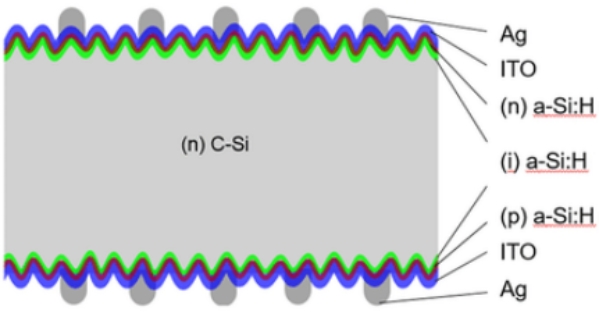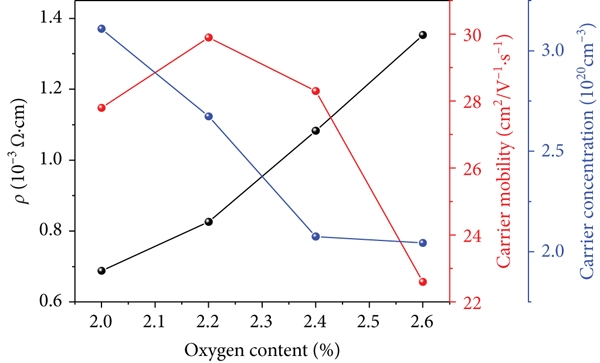With the rapid iteration of solar cell technology, heterojunction solar cells have attracted widespread attention due to their advantages such as high conversion efficiency, high open circuit voltage, low temperature coefficient, low process temperature, and bifacial power generation. Among them, ITO films play an important role in heterojunction solar cells. During its preparation process, oxygen content, deposition temperature and sputtering power will have a certain impact on its electrical and optical properties.
Overview of Heterojunction Solar Cells
Using the n-type silicon wafer as the substrate, after cleaning and texturing, the intrinsic amorphous silicon film (ia-Si:H) and the n/p-type amorphous silicon film are sequentially deposited using the plasma deposition method. Enhanced chemical vapor deposition (PECVD) is performed on the front and back to form a back field and PN heterojunction to reduce carrier recombination. TCO films are then deposited on the front and back by DC magnetron sputtering (SP) for carrier transport. Finally, metal is printed on the front and back of the solar cell through screen printing to form a heterojunction with a double-sided symmetric structure, TCO layer/P-doped a-Si:H layer/intrinsic a-Si:H passivation layer/ c-Si wafer/intrinsic a-Si:H passivation layer/N-doped a-Si:H layer/TCO layer. However, the emitter of heterojunction solar cells is amorphous silicon, so it is necessary to introduce a TCO film between the amorphous silicon layer and the metal electrode to ensure the lateral transmission of current and reduce the problems caused by poor lateral transmission performance of traditional solar cells. Disadvantages of high heat loss.

Among many TCO films, ITO film is an n-type semiconductor transparent conductive oxide film with a band gap greater than 3.5 eV and a resistivity as low as 10-4Ω cm. It has unique optical properties, such as ultraviolet cutoff characteristics, high visible light transmittance, and high infrared light reflectivity. In the process of preparing ITO films, oxygen content, deposition temperature and sputtering power have a certain impact on the transmittance and conductivity of ITO films, and also have an impact on the performance of HJT solar cells.
Effect of oxygen content on electrical and optical properties of ITO films
1. Electrical properties
The oxygen content is sensitive to the transmittance and resistivity of the ITO film. ITO films prepared with different oxygen contents have different carrier mobility, carrier concentration, resistivity, and transmittance. The conductivity of ITO films mainly relies on oxygen vacancies and heteroatom doping to provide carriers. 1 Sn4+ instead of In3+ can provide 1 electron, and 1 oxygen vacancy can provide 2 electrons; however, the mobility is related to the scattering mechanism in the film.

As can be seen from the above figure, the carrier concentration decreases with the increase of oxygen content, which is caused by the decrease of oxygen vacancies. As the oxygen content increases, the mobility first increases and then decreases. When the oxygen content is 2.2%, the mobility reaches a maximum value of 29.9 cm-2/V-2·s-1; however, when the oxygen content exceeds 2.2%, the mobility decreases. The abundant oxygen content makes oxygen ions in the film become oxygen impurities. Therefore, the scattering of carriers increases with increasing oxygen content, resulting in a decrease in carrier mobility and an increase in resistivity with increasing oxygen content. According to ρ=Nμ, the resistivity of the ITO film is related to the carrier concentration and mobility, and is inversely proportional to the product of the carrier concentration and mobility. At the beginning, due to insufficient oxygen, there were many oxygen vacancies in the ITO film, resulting in higher carrier concentration and lower resistivity. Thereafter, as the oxygen content increases, the carrier concentration and mobility in the film decrease and the resistivity increases.
2. Optical properties
The transmittance of ITO films is mainly related to two wavelength regions, namely the medium and short wavelength regions and the long wavelength region. The transmittance in the medium and short wavelength region is mainly related to the bandgap width of the material, while the transmittance in the long wavelength region is mainly related to the carrier concentration. Excessively high carrier concentration will interact strongly with the incident light, thus affecting the transmittance of the film. As can be seen from the figure below, as the oxygen content increases, the transmission of the ITO film first increases and then decreases slightly. Due to the formation of high-valent compounds under high oxygen content conditions, the light transmittance of the film rises to more than 90%. When the oxygen content continues to be increased, the transmittance decreases again, which may be due to the absorption of excess oxygen ions by the grain boundaries and the enhanced scattering of the sample by defects in the sample.
